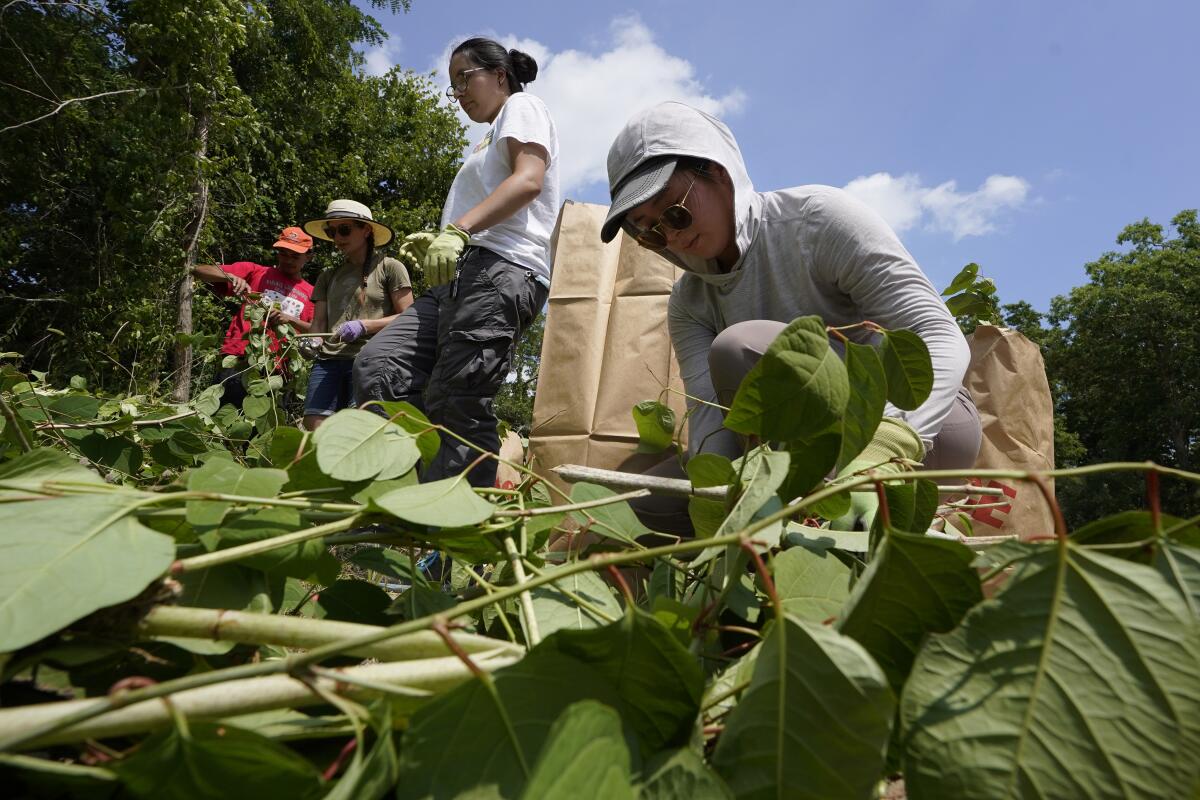Native groups seek to restore lands altered by European colonization

- Share via
KINGSTON, Mass. — Asa Peters marched into a thicket of Japanese knotweed in the woods of coastal Massachusetts this month and began steadily hacking the towering, dense vegetation down to size.
The 24-year-old member of the Mashpee Wampanoag tribe was among a cadre of volunteers rooting out invasive species and tending to recently planted native vegetation on a wide swath of forest acquired on behalf of his federally recognized tribe and other Wampanoag communities.
“It’s hard. You got to keep pulling and pulling. Starting to really sweat, but it’s cool,” he said as he took a quick break in the sweltering August heat. “We’re in the early stages, putting in the work to create a special place where we can do all kinds of great things.”
The Wampanoag Common Lands, as the project is called, seeks to restore a 32-acre former Catholic summer camp on the banks of the Muddy Pond in Kingston to something closer to what it might have looked like before European colonization transformed it.
The Native Land Conservancy, the local Native group that received the donated land this year, envisions a natural environment filled with indigenous plants and animals where Wampanoags can practice cultural ceremonies and educate new generations in traditional ways.
Ramona Peters, a Mashpee Wampanoag who founded the conservancy, said the effort is all the more meaningful because the land is about five miles from where Pilgrims arriving on the Mayflower established the English colony of Plymouth, near the remnants of a Wampanoag community wiped out by European disease.
“This is basically where the first impact of colonization of this country happened,” she said. “It’s very significant that it’s been returned to us.”
The Wampanoag Common Lands is part of a growing movement of Indigenous-led conservation efforts helping to preserve and reinvigorate Native culture and identity, said Beth Rose Middleton Manning, a professor at UC Davis focused on Native American environmental policy and conservation.
The efforts are also critical in the face of climate change, which has acutely harmed Native communities, she said. Alaska tribes facing increased erosion, flooding and thawing permafrost have weighed relocating from their coastal and riverside lands. Louisiana bayou tribes still reeling from Hurricane Ida last year are bracing for ever-more powerful storms, while across the American West, tribes are contending with a historic drought that has upended their way of life.
“Many of our land and waterscapes have been pressed into extreme uses and depleted,” Middleton Manning said. “Land stewardship and care work are necessary for creating resilient landscapes.”
In Northern California, the Wiyot tribe has spent more than two decades restoring a badly polluted island that was the site of an 1860 massacre that nearly wiped out the tribe and, more recently, was home to a ship repair facility.
Michelle Vassel, the tribe’s administrator, said the years of environmental work on Tuluwat Island have contributed to better water quality and marine habitats across Humboldt Bay.
“For us, it’s a responsibility. Indigenous people are tied to a place,” she said. “This work is also healing. The history of the massacre has always been a scar on the broader community. This was a way to change that history.”
Tribes in Wyoming and other Great Plains states, meanwhile, have been reintroducing bison herds brought to near extinction by European settlers. In Washington state and other parts of the Pacific Northwest, Native Americans are focused on protecting glacial rivers vital for migrating salmon from warming waters and the effects of dams and pollution.
And on the Massachusetts island of Martha’s Vineyard, the Native-run Sassafras Earth Education has been teaching youths and families traditional Wampanoag cultivation practices for decades.
The organization’s Land Culture Project seeks to transform roughly 20 acres of forested land and fields into a “highly productive food forest” of native trees and shrubs beneficial to people and wildlife.
“It’s not just about restoring the physical land,” said Saskia Vanderhoop, who founded the organization with her husband, David Vanderhoop, an Aquinnah Wampanoag elder. “It’s also about restoring the culture.”
At the nearby Wampanoag Common Lands, old summer camp buildings were torn down and pavement, athletic courts and other hard surfaces scraped away this year.
Even large, nonnative Norwegian spruce trees were uprooted by the prior owners at the conservancy’s request, leaving mostly a bare clearing near the water’s edge.
In their place, conservancy staff and volunteers this summer planted dozens of native species significant to Wampanoag culture, such as white oak trees, blueberry bushes, witch hazel, goldenrod and hay-scented ferns.
Wildlife cameras have been set up to survey and monitor otters, deer and other local fauna. The conservancy is also building bat houses and is considering reintroducing threatened and rare native animal species, such as northern red-bellied turtles, said Diana Ruiz, the Native Land Conservancy’s director.
The organization is also exploring other uses, such as traditional Wampanoag lodges for hosting guests or other community functions.
“We’re not looking at it as just this closed system that humans sometimes visit,” she said. “We’re looking at it as a space where the Wampanoag community can reconnect with their ancestral homeland in an active and deep way.”
For Asa Peters, that potential for spiritual revitalization is what he finds most compelling about the land project.
He looks forward to returning years from now to see not just how the plants he helped nourish take hold, but also how Wampanoags use the restored land.
“My hope for it is to be a beautiful, comfortable space,” Peters said. “A place where people can come and it helps fill them back up.”
More to Read
Sign up for Essential California
The most important California stories and recommendations in your inbox every morning.
You may occasionally receive promotional content from the Los Angeles Times.










